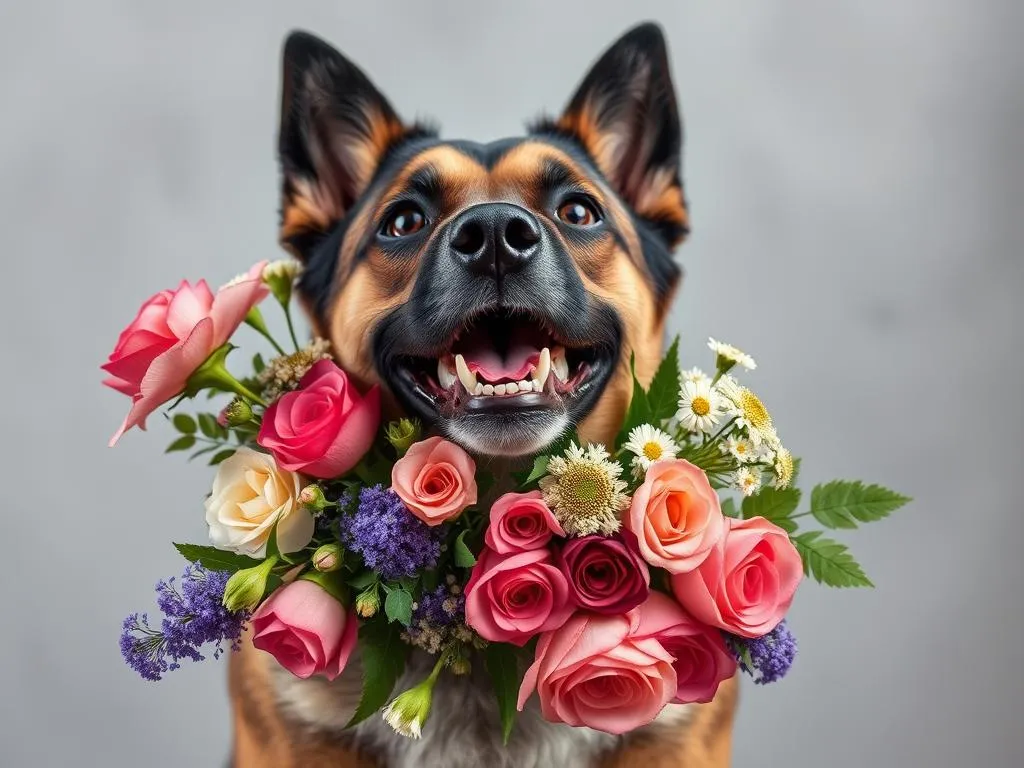
Introduction
Dog health care is not just a routine; it’s an essential part of being a responsible pet owner. Just like humans, dogs require regular check-ups, vaccinations, and proper nutrition to lead a long, healthy life. Understanding the nuances of dog health care goes beyond just vet visits; it includes knowing the environment they live in, the food they consume, and even the plants around them. One vital aspect that often gets overlooked is the significance of dog-safe bouquets. As many dog owners wish to beautify their homes or celebrate special occasions with flowers, it’s crucial to understand which ones are safe for our furry friends.
In this article, we’ll delve into various aspects of dog health care, ranging from the importance of regular check-ups to identifying common health issues. We’ll also explore the fascinating world of dog-safe bouquets and how to select flowers that won’t harm your pet. By the end, you’ll be well-equipped to create a safe and healthy environment for your beloved dog.
Understanding Dog Health Care
Importance of Regular Health Check-ups
Regular health check-ups are crucial for detecting potential health issues early on. Annual veterinary visits allow for a thorough examination of your dog’s overall health and well-being. During these visits, vets can identify common issues such as obesity, dental problems, and skin conditions before they escalate into more severe problems. Additionally, routine blood tests can uncover underlying health issues related to organs like the liver or kidneys. Establishing a good relationship with your veterinarian can significantly improve your dog’s quality of life.
Vaccinations and Preventive Care
Vaccinations are a cornerstone of preventive care in dogs. Essential vaccinations protect against dangerous diseases such as rabies, parvovirus, and distemper. Keeping up with your dog’s vaccination schedule is vital in preventing the spread of these illnesses. Furthermore, preventive care extends to flea, tick, and heartworm prevention. Fleas and ticks can lead to severe skin irritations and transmit diseases, while heartworm disease can be fatal if left untreated. Regular preventive measures can save you and your dog from unnecessary suffering and expensive treatments in the long run.
Nutrition and Diet
Proper nutrition is foundational to maintaining your dog’s health. A balanced diet ensures your dog receives the necessary nutrients for energy, growth, and overall well-being. Different breeds have varying dietary needs based on size, age, and activity level. For instance, puppies require more calories and nutrients than adult dogs, while senior dogs may need a diet lower in calories but higher in fiber. Always consult your veterinarian for personalized dietary recommendations to meet your dog’s specific requirements.
Common Health Issues in Dogs
Allergies
Dogs can suffer from various allergies, which can be broadly classified into food allergies and environmental allergies. Food allergies often manifest as gastrointestinal issues or skin irritations, while environmental allergies may cause symptoms like itching, sneezing, or ear infections. Treatment options vary, but they may include a change in diet, medication, or allergy shots. Observing your dog’s reactions to certain foods or environmental factors can help you pinpoint the cause of their discomfort.
Obesity
Obesity is a growing concern among dogs and can lead to severe health complications such as diabetes, arthritis, and heart disease. Contributing factors include overfeeding, lack of exercise, and certain medical conditions. To combat obesity, focus on maintaining a healthy diet and incorporating regular exercise into your dog’s routine. Simple activities like daily walks, playtime, and mental stimulation can significantly impact your dog’s weight management.
Dental Health
Dental hygiene is often overlooked but is crucial for a dog’s overall health. Poor dental care can lead to periodontal disease, which may result in tooth loss and infections affecting the heart, liver, and kidneys. Regular dental check-ups and cleanings, along with at-home care such as brushing your dog’s teeth and providing dental chews, can help maintain their dental health. Symptoms of dental disease may include bad breath, difficulty eating, or inflamed gums, so it’s essential to monitor your dog’s oral health closely.
Dog-Safe Bouquets and Plants
Introduction to Dog-Safe Bouquets
Creating a beautiful indoor space with flowers can enhance your home, but it’s crucial to ensure that the flowers you choose are safe for your dog. Dog-safe bouquets consist of flowers and plants that do not pose a risk to your pet’s health. Many common flowers can be toxic, leading to gastrointestinal upset or more severe reactions like organ failure. Understanding which flowers are safe and which to avoid is essential in creating a pet-friendly environment.
List of Dog-Safe Flowers
Here’s a detailed list of flowers that are generally considered safe for dogs:
- Roses: Not only are they beautiful, but they are also non-toxic to dogs. Just be cautious of the thorns.
- Sunflowers: These cheerful flowers are safe and can brighten any room.
- Gerbera Daisies: Known for their vibrant colors, these flowers are also safe for dogs.
- Zinnias: A hardy flower that adds a splash of color and is safe for your canine companion.
- Marigolds: These bright flowers can deter some pests while being safe for dogs.
Each of these flowers can bring beauty and joy to your home without endangering your furry friend.
Toxic Plants and Flowers to Avoid
While many flowers are safe, several common plants and flowers are toxic to dogs and should be avoided at all costs:
- Lilies: Especially dangerous, lilies can cause kidney failure in dogs.
- Azaleas: Ingestion can lead to vomiting, diarrhea, and potentially fatal heart issues.
- Oleander: Highly toxic, even a small ingestion can cause severe heart problems.
- Sago Palm: This plant is extremely toxic; ingestion can be fatal.
- Daffodils: These spring flowers can cause severe gastrointestinal distress.
If you suspect your dog has ingested a toxic plant, seek veterinary care immediately.
Creating Your Own Dog-Safe Bouquets
When creating your own dog-safe bouquets, consider the following tips:
- Mix Safe Flowers: Combine various dog-safe flowers to create a vibrant bouquet.
- Seasonal Options: Utilize seasonal flowers that are safe to keep your arrangements fresh and appealing.
- Occasions: For holidays or special occasions, consider using flowers that match the theme while remaining safe, such as red roses for Valentine’s Day or sunflowers for summer events.
By being mindful of the flowers you choose, you can create stunning arrangements that enhance your space without compromising your dog’s safety.
Maintaining a Healthy Environment for Dogs
Safe Indoor Spaces
Creating a safe indoor environment is crucial for your dog’s health and well-being. Dog-proofing your home involves removing or securing items that could be harmful to your pet. Common household items that can pose risks include:
- Cleaning Supplies: Many cleaning products are toxic to dogs. Store them out of reach or use pet-safe alternatives.
- Electrical Cords: Tuck away cords to prevent chewing and potential electrical hazards.
- Small Items: Items like coins, batteries, and small toys can be choking hazards.
By being proactive about your pet’s environment, you can prevent accidents and health issues.
Outdoor Safety
An outdoor space can provide your dog with much-needed exercise and mental stimulation. When creating a safe outdoor environment, consider the following tips:
- Secure Fencing: Ensure your yard is securely fenced to prevent escapes and protect against other animals.
- Shade and Water: Provide shaded areas and fresh water to keep your dog cool and hydrated, especially during hot weather.
- Regular Exercise: Incorporate regular walks, playtime, and outdoor activities to keep your dog physically and mentally engaged.
A safe and stimulating outdoor environment not only enhances your dog’s physical health but also contributes to their emotional well-being.
Conclusion
In summary, dog health care is a multifaceted responsibility that encompasses regular veterinary visits, vaccinations, nutrition, and creating a safe environment. Understanding the significance of dog-safe bouquets adds another layer of care, ensuring that your home is a safe haven for your furry friend. By prioritizing your dog’s health and safety, you contribute to their happiness and longevity.
FAQs
What are the signs my dog may need a vet visit?
Common signs include changes in appetite, lethargy, vomiting, diarrhea, or any unusual behavior. If you notice these signs, consult your veterinarian.
How often should my dog see the vet?
Most dogs should have an annual check-up. However, older dogs or those with existing health issues may require more frequent visits.
Are all flowers safe for dogs?
No, many flowers can be toxic to dogs. Always research or consult a veterinarian before introducing new plants or flowers into your home.
What should I do if my dog eats something toxic?
Contact your veterinarian or an emergency pet poison hotline immediately for guidance on how to proceed.
How can I maintain my dog’s dental health?
Regular brushing, dental chews, and professional cleanings can help maintain your dog’s dental health.









